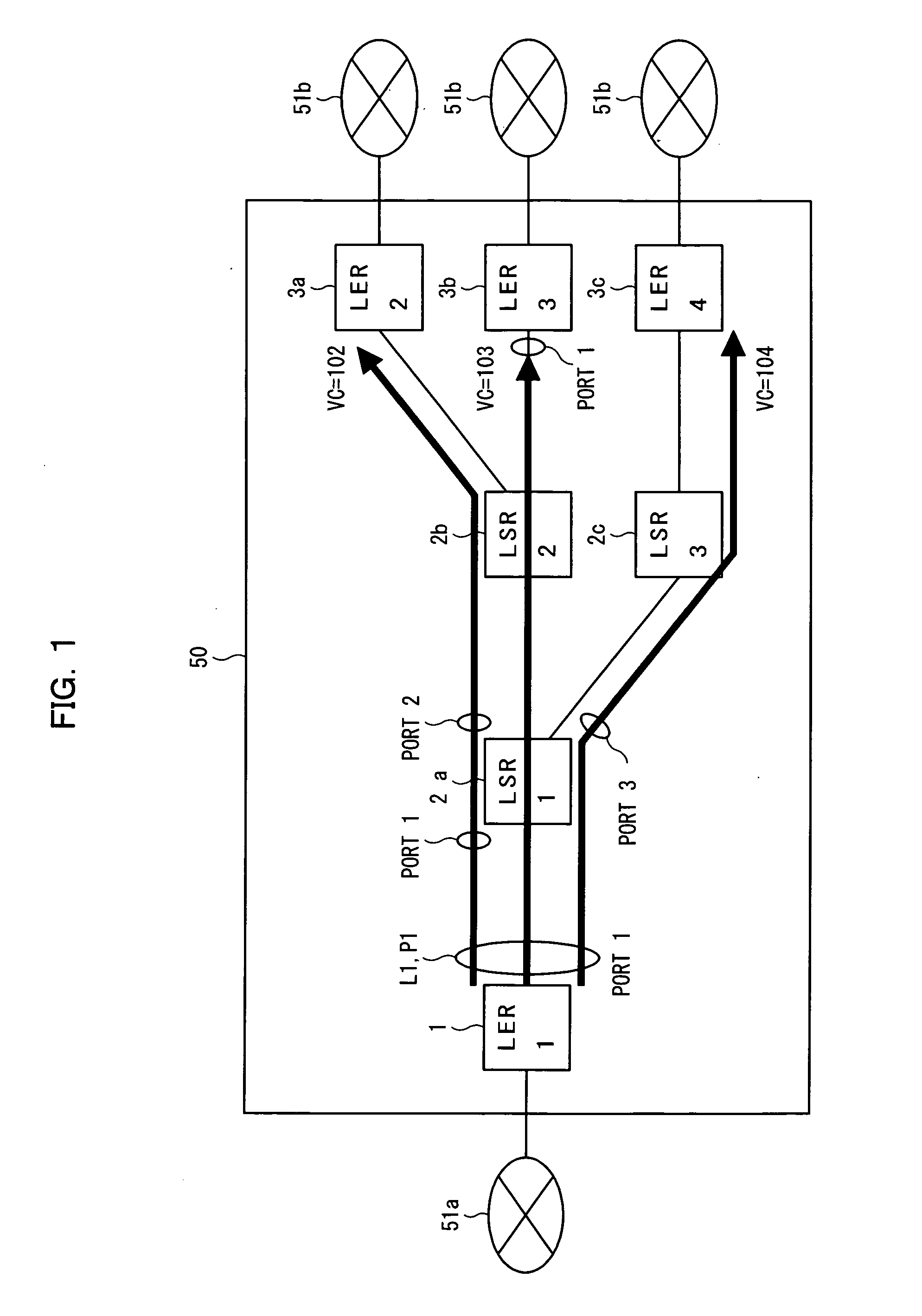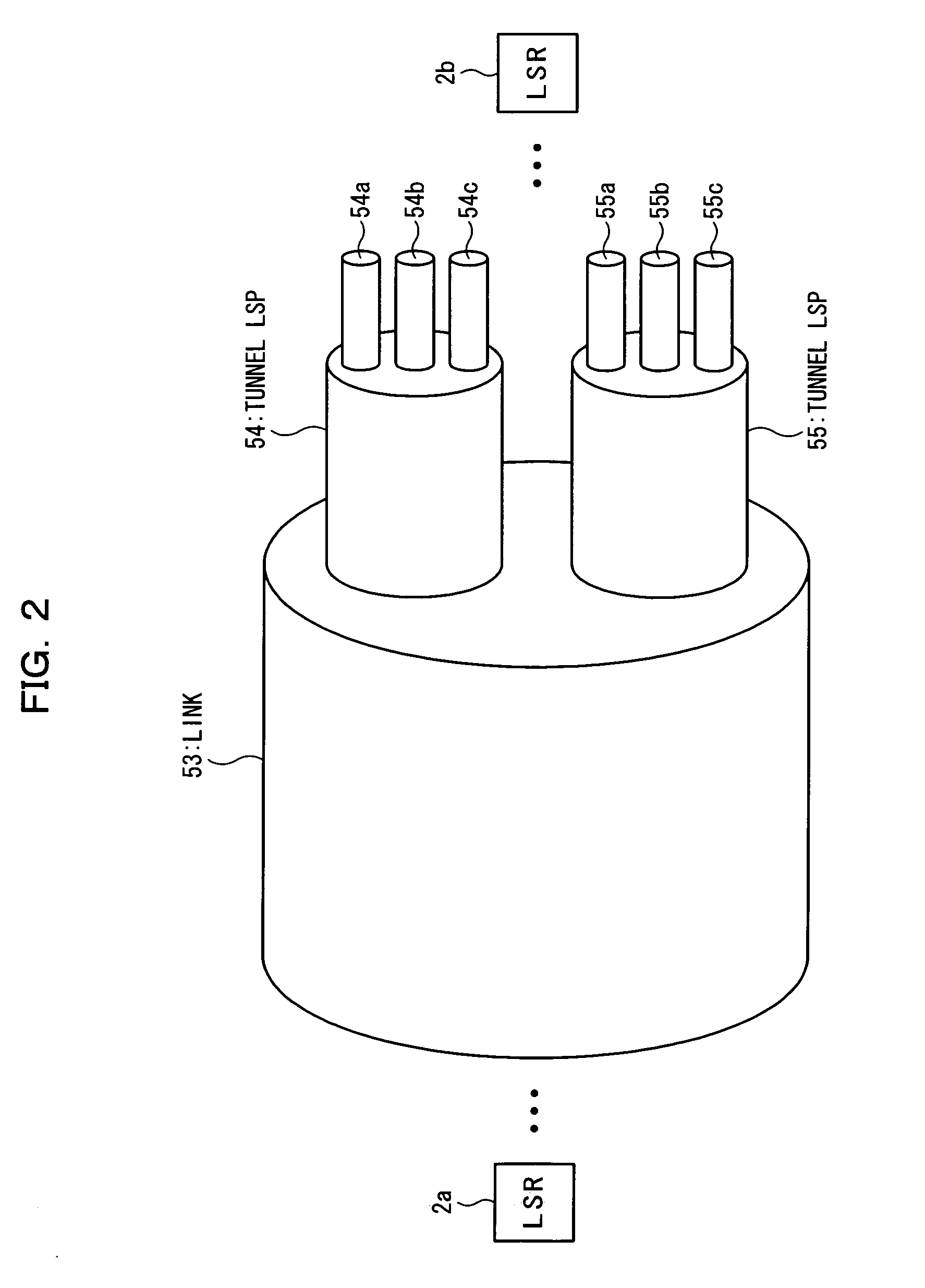Router, frame forwarding method, and lower layer frame virtual forwarding system
a frame forwarding and frame forwarding technology, applied in data switching networks, multiplex communication, digital transmission, etc., can solve the problems of ldp not having the function of securing the bandwidth of lsp, reducing the use efficiency of the band, so as to prevent wasteful frame duplication, reduce the load on the network, and efficiently use the band in the virtual network
- Summary
- Abstract
- Description
- Claims
- Application Information
AI Technical Summary
Benefits of technology
Problems solved by technology
Method used
Image
Examples
first embodiment
(A) Description of First Embodiment of the Invention
[0196]FIG. 1 is a schematic diagram of a MPLS-Layer2-VPN (a Layer 2 virtual network or a VPN network to which MPLS is applied; hereinafter referred to as a MPLS network) according to a first embodiment of this invention. An MPLS network 50 shown in FIG. 1 can transfer a layer 2 frame (lower layer frame) including a protocol identifier for identifying duplication or non-duplication and a MPLS frame (label switch frame) having hierarchical path identifiers such as a tunnel label, a VC label and the like on the basis of the tunnel label and the VC label.
[0197] Here, a thick black line connecting routers represents the VC label. The tunnel label in VPLS represents a path connecting PEs (provider edge routers, represented as LER) in the MPLS network 50.
[0198] The protocol identifier identifies both multicast, where a plurality of routers (router addresses or router destinations) are designated and the same data is transmitted thereto,...
second embodiment
(B) Description of Second Embodiment of the Invention
[0335] When it is necessary to forward a frame from the same output port to a plurality of relay routers, the ingress router according to a second embodiment handles the frame as a multicast MPLS frame, selects one among user identification LSPs for forwarding unicast traffics, and forwards the frame. When the relay router receives the frame, the label switching unit duplicates the frame as required and forwards the same. Finally, the frames are forwarded with all the necessary user identification LPSs for unicast.
[0336] According to the second embodiment, the user identifying function and the user point identifying function are given to the VC label. Why the user identifying function is required is that each egress router learns the address. Each of the egress routers 3a through 3c requires information about from which ingress node the frame is transmitted. For example, the VC label value 25 is used to identify both the user and...
sixth embodiment
(F) Description of Sixth Embodiment
[0439] A sixth embodiment is a modified variation of the fifth embodiment.
[0440] In the known frame forwarding method, tunnel LSP and VCLSP are both set point-to-point. To the contrary, in a frame forwarding method according to the sixth embodiment, both tunnel LSP and VCID are used as a MPLS label used for forwarding, and a point-to-multipoint path is newly set to these tunnel LSP and VCID. Here, VCID has meanings of both user identification and user point identification.
[0441]FIG. 22 is a diagram of a structure of an MPLS network 50 according to the sixth embodiment of this invention. The MPLS network 50 shown in FIG. 22 comprises the ingress router 1d, the relay routers 2p through 2r and egress routers 3d through 3f. Among them, the ingress router 1d and the relay routers 2p through 2r are the same as those described above.
[0442] Between neighboring routers among the routers shown in FIG. 22, only a VC label (denoted by black line) is set, bu...
PUM
 Login to View More
Login to View More Abstract
Description
Claims
Application Information
 Login to View More
Login to View More - R&D
- Intellectual Property
- Life Sciences
- Materials
- Tech Scout
- Unparalleled Data Quality
- Higher Quality Content
- 60% Fewer Hallucinations
Browse by: Latest US Patents, China's latest patents, Technical Efficacy Thesaurus, Application Domain, Technology Topic, Popular Technical Reports.
© 2025 PatSnap. All rights reserved.Legal|Privacy policy|Modern Slavery Act Transparency Statement|Sitemap|About US| Contact US: help@patsnap.com



